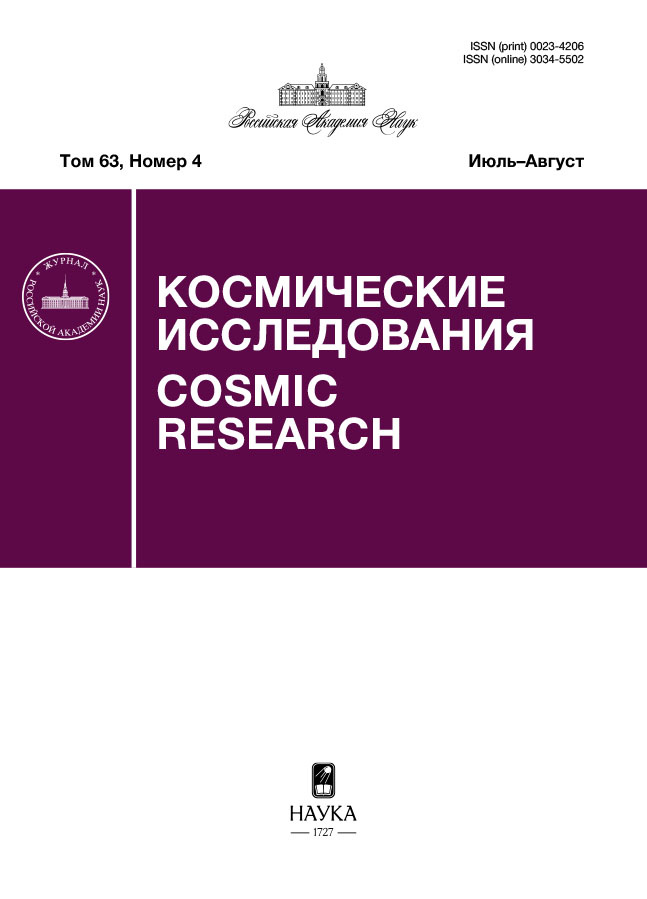On the design of the orbital constellation of a lunar global navigation satellite system
- Авторлар: Avdyushev V.A.1, Popandopulo N.A.1
-
Мекемелер:
- Research Institute of Applied Mathematics and Mechanics, Tomsk State University
- Шығарылым: Том 63, № 4 (2025)
- Беттер: 395-406
- Бөлім: Articles
- URL: https://clinpractice.ru/0023-4206/article/view/692313
- DOI: https://doi.org/10.31857/S0023420625040053
- EDN: https://elibrary.ru/qnlrvo
- ID: 692313
Дәйексөз келтіру
Аннотация
Based on the results of numerical modeling and investigation of orbital structures in the lunar dynamic space, this article proposes an original orbital grouping of the lunar global navigation satellite system in quasi-frozen highly elliptical and highly inclined orbits. The proposed grouping has structural stability and provides effective navigation coverage. The search for such a configuration of the lunar GNSS was carried out by varying the positional orbital elements in wide ranges: the semimajor axis from 4 to 12 radii of the Moon, the eccentricity from 0 to 0.7, and the inclination from 40°to 65°.
Авторлар туралы
V. Avdyushev
Research Institute of Applied Mathematics and Mechanics, Tomsk State University
Email: sch@niipmm.tsu.ru
Tomsk, Russia
N. Popandopulo
Research Institute of Applied Mathematics and Mechanics, Tomsk State University
Хат алмасуға жауапты Автор.
Email: sch@niipmm.tsu.ru
Tomsk, Russia
Әдебиет тізімі
- Zelenyi L., Petrukovich A., Khartov V.V. et al. Russian Lunar Space Program // Proc. 40th COSPAR Scientific Assembly. 2014. Moscow, Russia. Abstract ID. B0.1-5-14.
- Микрин Е.Л., Михайлов М.В., Орловский И.В. и др.Спутниковая навигация окололунных космических аппаратов и объектов на поверхности Луны // Гироскопия и навигация. 2019. С. 22–31.
- Дмитриев А.О., Москатиньев И.В., Нестерин И.М. и др. Анализ вариантов навигационных систем для Луны // Труды МАИ. 2021. № 118. С. 1–38.
- Carosi M., Capolicchio J., Tosti M. et al.Comparison among Orbital Constellation for a Global Lunar Satellite Navigation System // Proc. Joint 26th Ka and Broadband Communications Conference and the 38th International Communications Satellite Systems Conference. Virginia, USA. 2021.
- Walker J.G.Satellite constellations // J. British Interplanetary Society. 1984. V. 37. P. 559–571.
- Ely T.A.Stable Constellations of Frozen Elliptical Inclined Lunar Orbits // J. Astronautical Sciences. 2005. V. 53. Iss. 3. P. 301–316.
- Ely T.A., Lieb E.Constellations of elliptical inclined lunar orbits providing polar and global coverage // J. Astronautical Sciences. 2006. V. 54(1). P. 53–67.
- Howell K.C.Three-Dimensional, Periodic, 'Halo' Orbits // Celestial Mechanics. 1984. V. 32. Iss. 1. P. 53–71.
- Wang K., Li K., Lv S. et al.Multi-orbit lunar GNSS constellation design with distant retrograde orbit and Halo orbit combination // Scientific Reports. 2023. V. 13. Art.ID. 10158. doi: 10.1038/s41598-023-37348-x.
- Gao Z., Hou X. Coverage Analysis of Lunar Communication/Navigation Constellations Based on Halo Orbits and Distant Retrograde Orbits // J. Navigation. 2020. V. 73(2). P. 282–300. doi: 10.1017/S0373463320000065.
- Лидов М.Л.Эволюция орбит искусственных спутников под воздействием гравитационных возмущений внешних тел // Искусственные спутники Земли. 1961. Вып. 8. С. 5–45.
- Kozai Y.Secular perturbations of asteroids with high inclination and eccentricity // Astron. J. 1962. V. 67. P. 591–598.
- Shevchenko I.The Lidov–Kozai Effect — Applications in Exoplanet Research and Dynamical Astronomy. Springer International Publishing, 2017.
- Valtonen M.J., Karttunen H. The three-body problem. Cambridge University Press, 2005.
- Попандопуло Н.А., Александрова А.Г., Томилова И.В. и др. Численное моделирование динамики искусственных спутников Луны// Астрономический вестник. Исследования Солнечной системы. 2022. Т. 56. № 4. С. 266–284. doi: 10.31857/S0320930X22040077.
- Spherical Harmonic ASCII Model of the gravity fields of Earth's Moon GRGM1200L. 2021.https://pds-geosciences.wustl.edu/grail/grail-l-lgrs-5-rdr-v1/grail_1001/shadr/gggrx_1200l_bouguer_sha.tab
- Folkner W.M., Park R.S.Planetary ephemeris DE438 for Juno // Tech. Rep. IOM 392R-18-004. Pasadena, CA: Jet Propulsion Laboratory, 2018.
Қосымша файлдар









